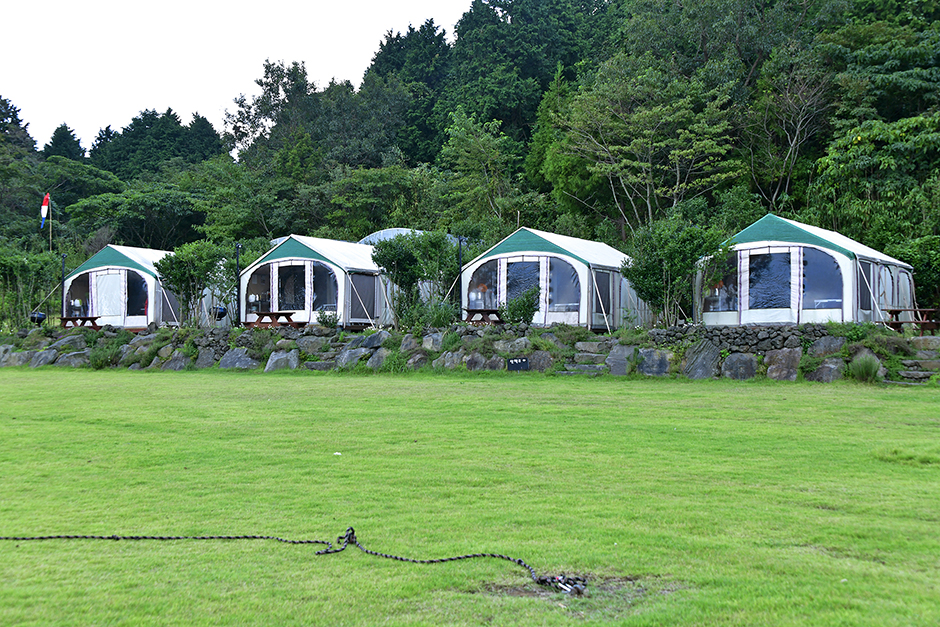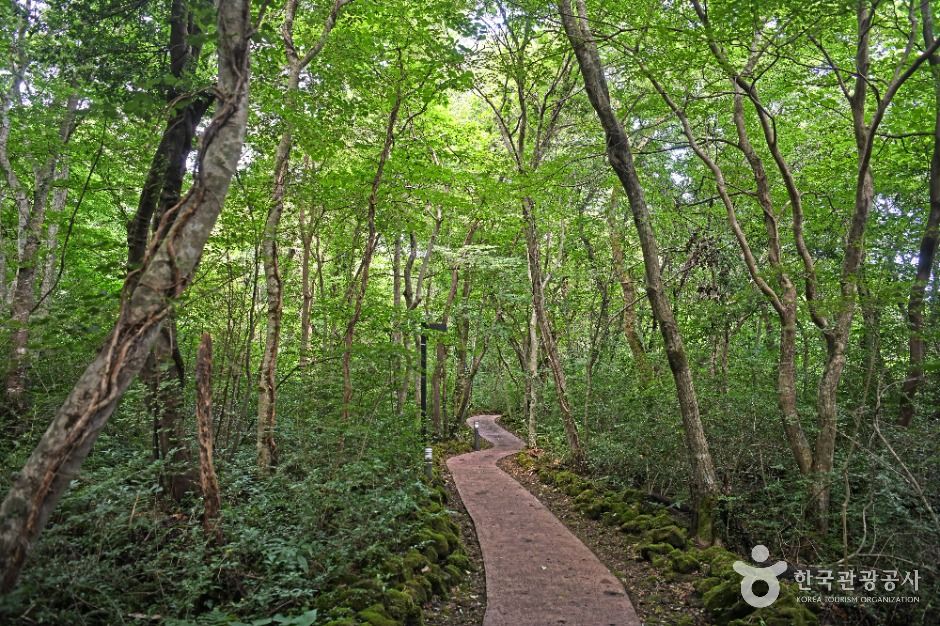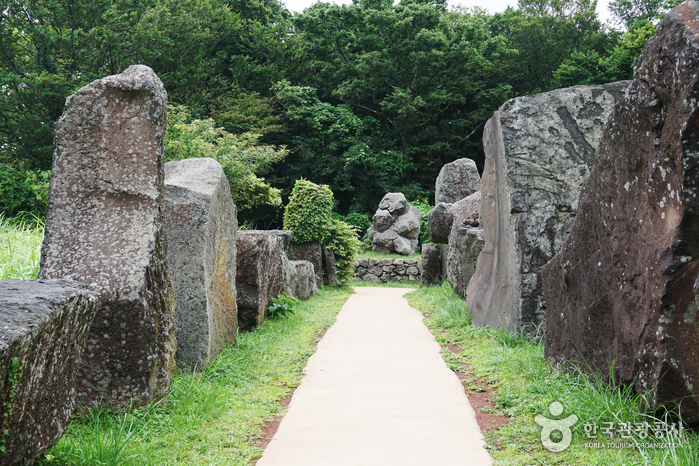Eco Land Theme Park (에코랜드테마파크)
9.5Km 2023-01-17
1278-169, Beonyeong-ro, Jeju-si, Jeju-do
+82-64-802-8000
Eco Land Theme Park is built in the 1 km² Gotjawal primeval forest. Visitors can explore around in a train that looks like an 1800s steam-powered Baldwin train. The seven Baldwin train look-alikes (Lincoln Train) operated in the park were specially ordered and manually manufactured in the UK. In the large Gotjawal forest with railway trails, visitors can see a variety of plants, animals, and insects living in the mysterious Gotjawal forests, while touring around by special train. It also has a lake for visitors to experience the ecosystem of the forest, take a walk and enjoy a picnic. Besides, there are many things to enjoy including Eco Bridge, Eco Windmill, Picnic Garden, Kid’s Town, Eco Road, Bare Foot on Scoria, Floating Café, and topiary artworks.
Gimnyeong Maze Park (김녕미로공원)
9.5Km 2024-03-13
122 Manjanggul-gil, Gujwa-eup, Jeju-si, Jeju-do
+82-64-782-9266
Gimnyeong Maze Park is intricately designed with towering evergreen trees, each reaching up to three meters in x_height, creating an natural labyrinth. The pathways are paved with scoria, a natural volcanic rock characteristic of Jeju, enhancing the authentic island feel. As visitors navigate the maze, the refreshing scent of evergreen trees fills the air, providing a sense of clarity and rejuvenation. Along the route, visitors can encounter unique dolmens and their feline residents. The park also features an observatory and a suspension bridge, offering breathtaking panoramic views. Gimnyeong Maze Park is a favorite destination for families, children and couples alike, providing a memorable experience for all.
Gimnyeongsagul Cave [UNESCO World Heritage] (김녕사굴 [유네스코 세계자연유산])
9.7Km 2022-12-29
34, Manjanggul-gil, Jeju-si, Jeju-do
+82-1600-0064
Gimnyeongsagul Cave is located close to Manjanggul Cave in the northeastern part of Jeju Island. The name of the cave, "Sagul," comes from the snake-like formation of the cave ("sa" meaning serpent). The entrance of the cave is wide like a serpent holding its mouth wide open, but once inside, the tunnel narrows resembling the body of a snake. Gimnyeongsagul Cave is a highly protected area and has been designated as Natural Monument along with Manjanggul Cave.
Jeju Best Hill (제주베스트힐)
9.8Km 2024-03-20
2109-36 Namjo-ro, Jocheon-eup, Jeju-si, Jeju-do
Best Hill is a campground at Namjo-ro, Jeju, at the foot of Banongoreum Parasitic Cone, surrounded by Gotjawal, a jungle-like forest featuring ferns growing on stone-rich land. It is located about 20 to 30 minutes from Jeju International Airport, so it is a good base camp for the surrounding tourist sites as well. Onsite facilities include the pension itself, glamping campground, drone game range, 3D experience, and hot air balloon experience. The pension features a variety of room arrangements, from Camellia to Herb, Meditation, Family, and Experience Rooms, for groups of all sizes. The glamping campground has private bathrooms attached to each tent for convenience. The hot air balloon experience allows riders to take part in the take-off and landing processes. There's a large grassy playground for kids and a covered swimming pool in the summer for hours of fun. Nearby sights include Eco Land Theme Park, Jeju Stone Park, Hamdeok Beach, and Saryeoni Forest Trail.
Yongcheondonggul Cave [UNESCO World Natural Heritage Site] (용천동굴 [유네스코 세계자연유산])
10.1Km 2020-11-27
Woljeong-ri, Jeju-si, Jeju-do
+82-1600-0064
Yongcheondonggul Cave is the most typical form of lava tunnel on Jeju Island and with a total length of approximately 2,470 meters, it is one of the largest. It has a unique topology and rich limestone formations such as lava terrace, lava shelves, lava waterfalls, and 140 meters of lava rolls. In particular, a range of carbonate formations such as straw soda, stalactite, columns, flowstones, cave corals, and aragonite crystals can be found inside this large cave that also contains a lake. This unique cave is astounding in terms of its geological value and beauty. There are also items that can be found throughout the cave that appear to have been brought in by people who lived on the island long ago, such as pieces of pottery, animal bones, ironware, charcoal and other substances.
* The UNESCO World Heritage inscribed Geomunoreum Lava Tube System consists of Bengdwigul, Manjanggul, Gimnyeonggul, Yongcheondonggul and Dangcheomuldonggul Caves.
Gyorae Natural Recreation Forest (교래자연휴양림)
10.1Km 2025-09-16
2023, Namjo-ro, Jocheon-eup, Jeju-si, Jeju-do
Gyorae Natural Recreation Forest, located in Jeju’s Gotjawal region, is a forest park divided into four zones. The recreation zone features forest thatched cottages and an outdoor performance venue. The camping zone includes campgrounds, an outdoor stage, and a futsal field. The ecological experience zone offers opportunities to observe the Gotjawal ecosystem. The forest bathing zone has a 3.5-km Oreum trail leading to Keunjigeuri Oreum. The forest is recognized as healing and relaxation space for people to unwind and find relief from the stresses of daily life.
Jeju Stone Park (제주돌문화공원)
10.1Km 2024-10-10
2023 Namjo-ro, Jocheon-eup, Jeju-si, Jeju-do
Located in Jocheon-eup, Jeju-si, Jeju Stone Park was inspired by Jeju's culture and applications of stones. The main theme focuses on the foundation and identity of Jeju Island, based on the myth of Seolmundae Halmang (Grandmother Seolmundae), who created Jeju Island and the stones of Obaek Janggun (Five Hundred Generals). The park serves as a historical and cultural space where collected stones respresent Jeju's foundation and culture.
Byeoldobong Peak (Beri Oreum) (별도봉(베리오름))
10.3Km 2025-08-18
Seonban-ro, Jeju-si, Jeju-do
+82-64-740-6000
Situated in the east of Hwabuk 1-dong and along the coast, Byeoldobong is a parasitic mountain made of siliciclastic sedimentary rocks and lava. Its northern slope is dominated by steep cliffs where a large rock called Jasalbawi Rock (Suicide Rock) is located. At the bottom of the cliffs are Goraegul Cave (Whale Cave) and an oddly-shaped rock that looks like a mother carrying her child on her back.
Despite being only 136m high, Byeoldobong is home to Jangsu Trail, a walking path that stretches over 1.8km around coastal cliffs, overlooking the ocean. Considered the most pleasant trail on Jeju Island, it offers a spectacular view of numerous peaks, Jeju Port and its nearby villages, and the emerald-blue sea. Naturally, it is a popular tourist destination for family visitors and couples.
Geomunoreum Lava Tube [UNESCO World Natural Heritage Site] (거문오름 [유네스코 세계자연유산])
10.4Km 2025-03-13
569-36 Seongyo-ro, Jocheon-eup, Jeju-si, Jeju-do
+82-64-710-8981
Geomunoreum Lava Tube stands out as one of the distinct oreum (the Jeju language term for parasitic cones) on Jeju Island, marked by its extensive network of around 20 lava tubes running through the volcanic structure. This site is not only a geological marvel but also a sanctuary for diverse biological species. Visitors begin their journey at the Jeju World Natural Heritage Center, from where a path leads directly to the Geomunoreum Lava Tube. It is important to note that prior reservations are required to visit. The significance of this location as a key geological feature was recognized when it was designated as a UNESCO World Natural Heritage Site in 2007. Additionally, an international trekking event is hosted annually to celebrate its global importance.
Jeju World Natural Heritage Center (제주 세계자연유산센터)
10.4Km 2021-05-31
569-36, Seongyo-ro, Jeju-si, Jeju-do
+82-1800-2002
The Jeju World Natural Heritage Center was established to acknowledge Jeju Island’s value as the sole UNESCO World Natural Heritage in Korea. It is comprised of various facilities including a 4D video room, lava tunnel experience, origins of Jeju-do, and many other activities that visitors can experience first-hand. Jeju World Natural Heritage Center is located in the Geomunoreum Lava Tube System, which was designated as a UNESCO World Natural Heritage in 2007, one of the 20 ecological tourism spots selected by the Ministry of Environment of Korea in 2009, as well as a Korean-style ecological tourism model.
* Opening date: September 4, 2012

![Gimnyeongsagul Cave [UNESCO World Heritage] (김녕사굴 [유네스코 세계자연유산])](http://tong.visitkorea.or.kr/cms/resource/37/1618237_image2_1.jpg)



![Geomunoreum Lava Tube [UNESCO World Natural Heritage Site] (거문오름 [유네스코 세계자연유산])](http://tong.visitkorea.or.kr/cms/resource/61/2661661_image2_1.jpg)
 English
English
 한국어
한국어 日本語
日本語 中文(简体)
中文(简体) Deutsch
Deutsch Français
Français Español
Español Русский
Русский